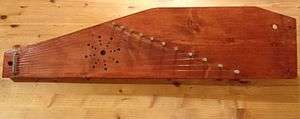Baltic psaltery

9-stringed kankles of northeastern Aukštaitija

11-stringed Latgale kokles

6-stringed kannel

9-stringed krylovidnye gusli
Baltic psaltery is a family of related plucked box zithers historically found in the south east vicinity of the Baltic Sea and played by the Baltic people, Baltic Finns, Volga Finns and northwestern Russians. These instruments include:
- Kanklės (Lithuania)
- Kantele (Finland, Karelia and Northwest Russia)
- Kannel (Estonia)
- Kāndla (Livonian people of Latvia)
- Kokles (Latvia)
- Kusle (Mari people of Russia)
- Krylovidnye gusli (Northwest Russia)
- Harpu (Sápmi)
The internationally most known instrument of the family is Finnish kantele, so it's name is sometimes used in English to also refer to the rest of the Baltic psalteries. Many of the Baltic psalteries hold a strong symbolic significance in their respective countries, including Finland, Latvia, Lithuania, Estonia and Russia, where playing training and instrument makers are available.[1]
Further reading
- Tëmkin, Ilya (January 2004). Evolution of the Baltic psaltery: a case for phyloorganology?. The Galpin Society Journal. Retrieved April 1, 2017.
References
- ↑ Djupsjöbacka, Tove (May 24, 2016). "The kantele – not exclusively Finnish". Finnish Music Quarterly. Retrieved May 24, 2017.
| Wikimedia Commons has media related to Baltic psaltery. |
This article is issued from
Wikipedia.
The text is licensed under Creative Commons - Attribution - Sharealike.
Additional terms may apply for the media files.